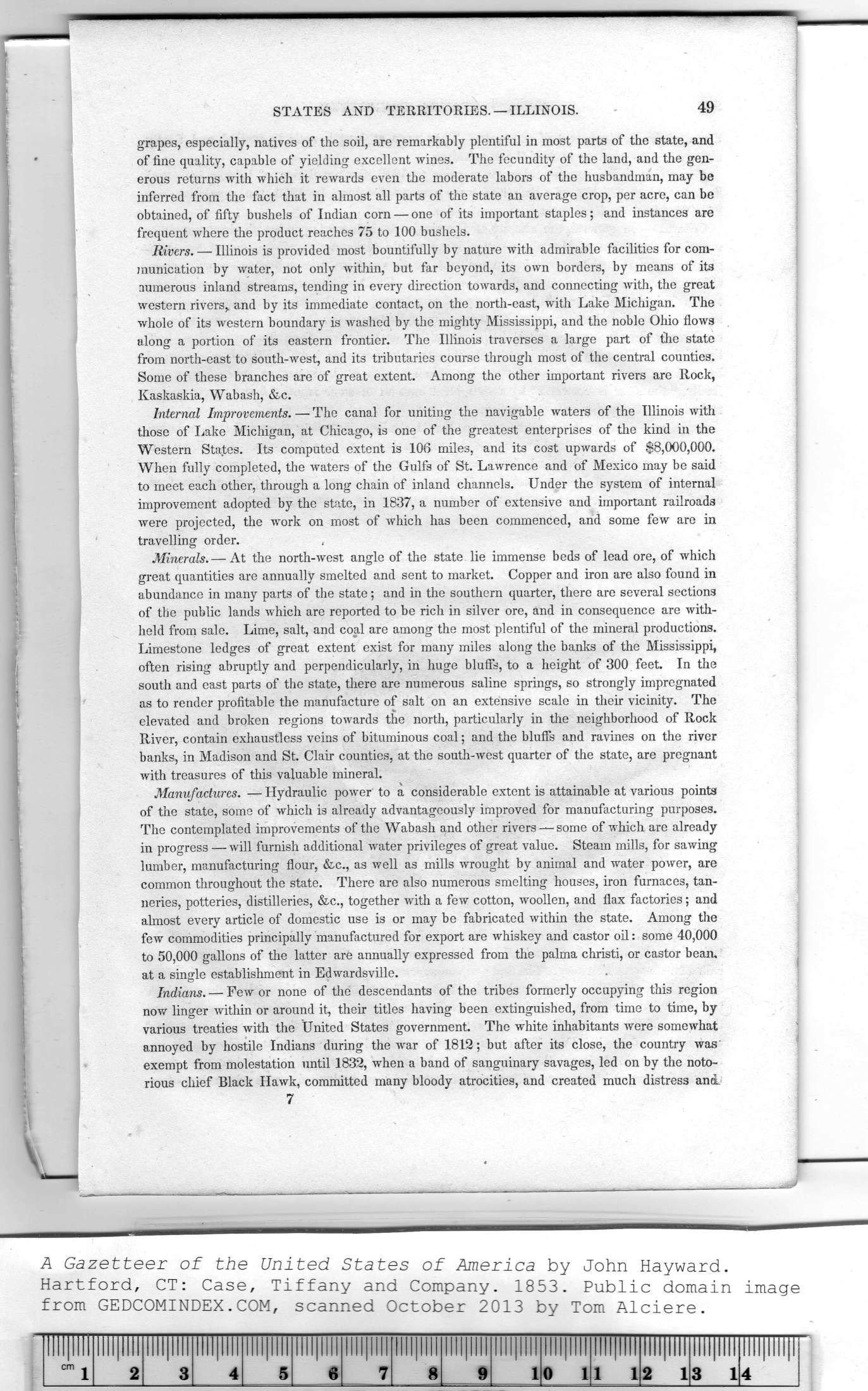|
|
Note: Ctrl and + increases the font size of the text below, Ctrl and - decreases it, and Ctrl and 0 resets it to default size.
STATES AND TERRITORIES.— ILLINOIS. 49
grapes, especially, natives of the soil, are remarkably plentiful in most parts of the state, and
of fine quality, capable of yielding excellent wines. The fecundity of the land, and the gen-
erous returns with which it rewards even the moderate labors of the husbandman, may be
inferred from the fact that in almost all parts of the state an average crop, per acre, can be
obtained, of fifty bushels of Indian corn — one of its important staples; and instances are
frequent where the product reaches 75 to 100 bushels.
Rivers. — Illinois is provided most bountifully by nature with admirable facilities for com-
munication by water, not only within, but far beyond, its own borders, by means of its
numerous inland streams, tending in every direction towards, and connecting with, the great
western rivers,, and by its immediate contact, on the north-east, with Lake Michigan. The
whole of its western boundary is washed by the mighty Mississippi, and the noble Ohio flows
along a portion of its eastern frontier. The Illinois traverses a large part of the state
from north-east to south-west, and its tributaries course through most of the central counties.
Some of these branches are of great extent. Among the other important rivers are Rock,
Kaskaskia, Wabash, &c.
Internal Improvements. — The canal for uniting the navigable waters of the Illinois with
those of Lake Michigan, at Chicago, is one of the greatest enterprises of the kind in the
Western States. Its computed extent is 106 miles, and its cost upwards of $8,000,000.
When fully completed, the waters of the Gulfs of St. Lawrence and of Mexico may be said
to meet each other, through a long chain of inland channels. Under the system of internal
improvement adopted by the state, in 1837, a number of extensive and important railroads
were projected, the work on most of which has been commenced, and some few are in
travelling order.
Minerals. — At the north-west angle of the state lie immense beds of lead ore, of which
great quantities are annually smelted and sent to market. Copper and iron are also found in
abundance in many parts of the state; and in the southern quarter, there are several sections
of the public lands which are reported to be rich in silver ore, and in consequence are with-
held from sale. Lime, salt, and coal are among the most plentiful of the mineral productions.
Limestone ledges of great extent exist for many miles along the banks of the Mississippi,
often rising abruptly and perpendicularly, in huge bluffs, to a height of 300 feet. In the
south and east parts of the state, there are numerous saline springs, so strongly impregnated
as to render profitable the manufacture of salt on an extensive scale in their vicinity. The
elevated and broken regions towards the north, particularly in the neighborhood of Rock
River, contain exhaustless veins of bituminous coal; and the bluffs and ravines on the river
banks, in Madison and St. Clair counties, at the south-west quarter of the state, are pregnant
with treasures of this valuable mineral.
Manufactures. — Hydraulic power to a considerable extent is attainable at various points
of the state, some of which is already advantageously improved for manufacturing purposes.
The contemplated improvements of the Wabash and other rivers — some of which are already
in progress —will furnish additional water privileges of great value. Steam mills, for sawing
lumber, manufacturing flour, &c., as well as mills wrought by animal and water power, are
common throughout the state. There are also numerous smelting houses, iron furnaces, tan-
neries, potteries, distilleries, &c., together with a few cotton, woollen, and flax factories; and
almost every article of domestic use is or may be fabricated within the state. Among the
few commodities principally manufactured for export are whiskey and castor oil: some 40,000
to 50,000 gallons of the latter are annually expressed from the palma christi, or castor bean,
at a single establishment in Edwardsville.
Indians. — Few or none of the descendants of the tribes formerly occupying this region
now linger within or around it, their titles having been extinguished, from time to time, by
various treaties with the United States government. The white inhabitants were somewhat
annoyed by hostile Indians during the war of 1812; but after its close, the country was
exempt from molestation until 1832, when a band of sanguinary savages, led on by the noto-
rious chief Black Hawk, committed many bloody atrocities, and created much distress and
7
|
lllllllll |
lllllllll |
llll|llll |
lllllllll |
llll|llll |
llll|llll |
mi ml |
llll|llll |
llll llll |
llll|IHI |
llll|llll |
lllllllll |
Mjllll flJip'flT |
!lll|l!ll|l |
|
cm j |
2 |
3 |
4 |
5 |
6 |
7 |
_8 |
9 |
1 |
0 1 |
1 1 |
2 13 1 |
4 |
|
